



The department of heavy industries (DHI) is likely to extend the first phase of Faster Adoption and Manufacturing of (Hybrid and) Electric vehicles (FAME) scheme by another six months with the government beginning to revamp the second phase of the scheme.
“With the deadline expiring on September 30, FAME-I is being extended till March, 2019 as the proposed second phase of FAME could not be sent to the cabinet,” said an official source.
“The period of the FAME India scheme is further extended for a period of six months i.e. up to September 30, 2018 or till date of launching of phase-II of FAME-India scheme, whichever is earlier,” DHI had said in a statement.
According to sources, officials at DHI have started modifying the proposed phase-II of the scheme after Prime Minister, Narendra Modi, raised questions on the subsidy framework.
Moneycontrol reported on September 11 that the PM dodged disclosing FAME-II at a global mobility summit, Move, as he was not “convinced” with the idea of subsidising electric vehicles. He, instead, asked officials to focus on reducing the cost of batteries which makes the vehicles expensive.
Sources said that the PMO was informed about modified special incentive package scheme (M-SIPS) by ministry of electronics and information technology (MeitY) which provides 20 (or 25 percent) percent capital subsidy on new and/or expansion of electronic-product manufacturing projects located in special economic zones (or non SEZs).
“The officials told the PM that M-SIPs is ‘difficult to implement’, so he asked officials to bring out strategies that would reduce cost of batteries,” sources said.
The officials, however, say that the proposal by PMO is difficult in execution as raw materials like lithium ion and magnet strips are not available in the country.
Presently, lithium ion batteries, used in electric cars, are supplied by countries like China, Hong Kong, Indonesia, the United States and Japan.
According to sources, DHI is contemplating charging “green cess” on petrol and diesel vehicles to raise the amount required to subsidise electric cars.
Also read: Electric vehicles: Government raises incentives under FAME-II to Rs 5,500 crore
“A green cess on conventional fuel-run vehicles could fetch close to Rs 3,000 crore. This amount from the market can be used to subsidise electric vehicles without the government having to shed a single penny,” people privy to the development said.
FAME India scheme was launched by DHI in 2015 to subsidise the purchase of electric vehicles. It offers subsidy up to Rs 22,000 on two wheelers, Rs 61,000 on three wheelers and Rs 1,87,000 on light commercial vehicles.
Under the second phase, a package of Rs 5,500 crore was approved by the finance ministry. Of this, Rs 1,000 crore was to be used for setting up charging infrastructure. Electric two/three/four wheelers were to receive subsidy of Rs 10,000 per kilowatt hour and buses were eligible for a subsidy of Rs 20,000 per kWh under the scheme.
The scheme was launched under ‘National Electric Mobility Mission Plan 2020’ by the United Progressive Alliance (UPA) government in 2013. FAME-I was introduced for two years, to be concluded in March 2017. It, however, received two extensions – till March 2018 and later till September 2018 -- owing to lack of consensus among National Institution for Transforming India (NITI) Aayog and various involved ministries.
Discover the latest Business News, Sensex, and Nifty updates. Obtain Personal Finance insights, tax queries, and expert opinions on Moneycontrol or download the Moneycontrol App to stay updated!
Find the best of Al News in one place, specially curated for you every weekend.
Stay on top of the latest tech trends and biggest startup news.